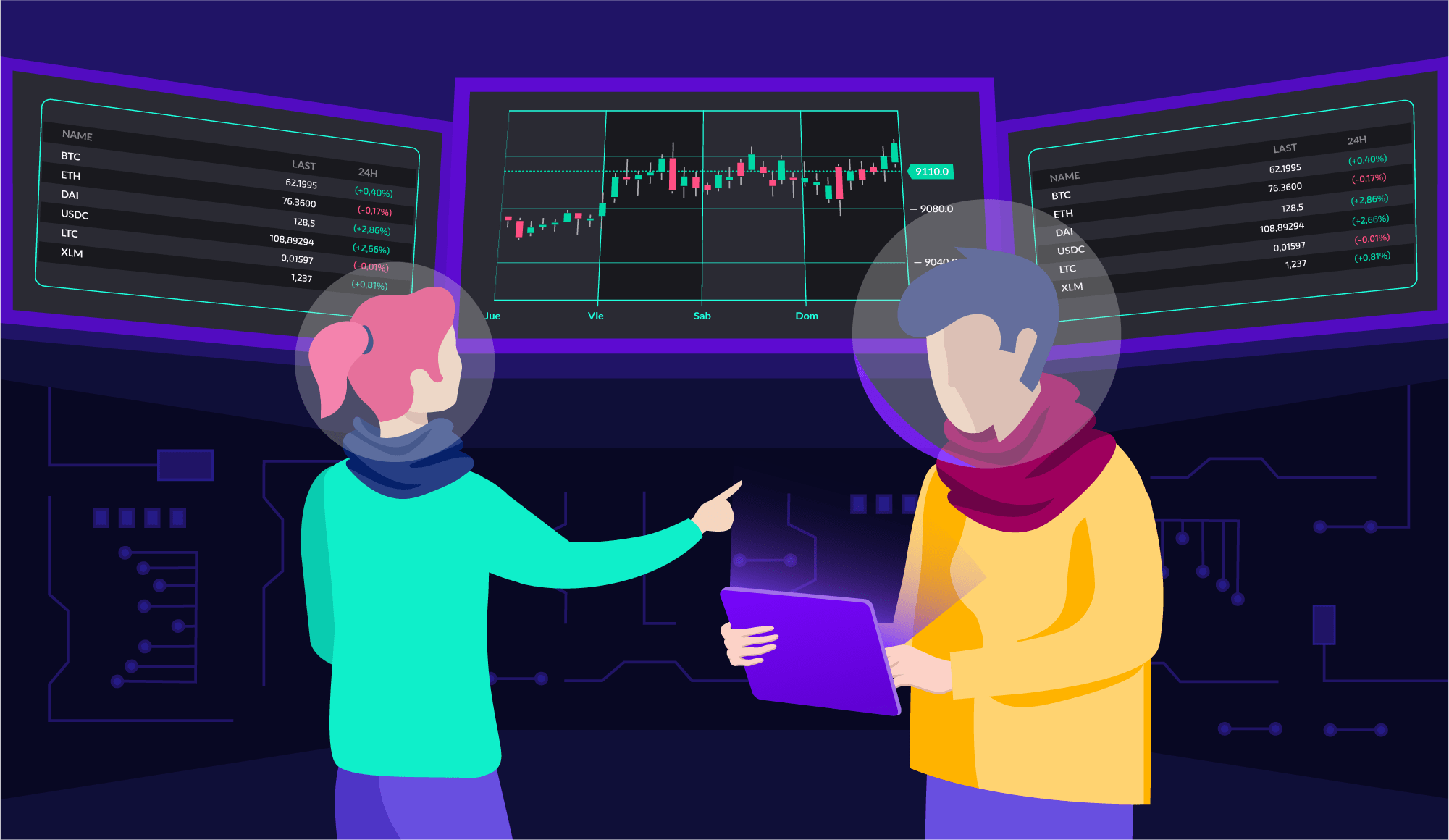Why are there so many different prices for bitcoin. Where you can buy and sell bitcoins. Why in each transaction there is a “price agreement”.

While changes in supply and demand determine the value of bitcoin minute by minute, there are two other factors that guide its price on a large scale.
First, bitcoin has value because there are 25 million users who trust and use it.
Furthermore, bitcoins are valuable because they are scarce goods: there will only be 21 million, and there are already 18 million in circulation. Being difficult and expensive to produce, to mine, also gives them value.
This price is not regulated by a State, central bank, mint or company. Therefore, although the amount fluctuates due to many factors, it is not affected by inflation.
The Bitcoin price agreement
All these elements come into play when two people agree on an amount that will satisfy both the seller and the buyer.
Throughout its history, that amount has ranged from fractions of cents in the early days of the Bitcoin network to nearly $20,000 in December 2017.

There are many ways to get bitcoins, and each type of tool or platform has different prices.
For each operation, those involved agree on a price. And the main reason for this variation is that not everyone buys and pays in the same way.
What is the best method { This will be defined by the urgency to obtain the bitcoins, the price sought, the desired payment method and the experience one has in cryptocurrencies.
Why are there so many different prices for a BTC?
Those who buy “in hand” from another person agree on a value and a commission that, depending on trust, the amount or the method of payment, lowers or increases the price.
Those who buy from other users through P2P (peer-to-peer) online platforms review the crypto sales “offers” and choose based on the best price, the payment method and the reputation of the seller.
Those who buy from an exchange can maintain “real-time” control of their purchase and choose to make it at the best possible price. You can also leave operations scheduled for when the BTC reaches the desired amount.
And those who buy from a broker access the amounts that that platform offers, a cost that is accepted in exchange for benefits such as security, simplicity and speed. Therefore, this is the most recommended way for novice users.
Peer-to-peer operations
How to operate with bitcoins between people. What risks do peer-to-peer operations have? How to find a P2P seller based on Bitcoin experience.

There are many ways to obtain bitcoins depending on the level of experience you have and the availability of capital that can be transferred to cryptocurrencies.
But, whatever the case, sooner or later a large part of users use a central method in the Bitcoin ideology: person-to-person or peer-to-peer operations.
Bitcoin is a peer-to-peer accounting system, created with the idea that it would become a tool for people to transfer value to each other directly, simply, cheaply and securely. However, this model also has its risks.
Risks of peer-to-peer trading
The original intention of the Bitcoin development team was to create a platform without intermediaries for the transfer of value through a cryptocurrency, bitcoin.
In theory, users would trade responsibly and honestly as a way to support the Bitcoin project. This was true at the beginning, but the community grew to such a point that it became impossible to scale trust among users of this currency.
The main problem with person-to-person (or P2P) buying and selling is the lack of security and trust between sellers and buyers, generally strangers.
In in-person operations, when interested parties meet so that one gives the money and the other transfers the crypto, fears of theft or scams are very common.

Bitcoin allows us to solve some security and trust problems when transferring value on the internet.
How to find a P2P crypto seller
Some are lucky enough to know a friend or family member who is already in the crypto world and can recommend a seller, but there is also a variety of channels to find them: forums, social networks, online communities, Telegram groups.
There, cryptocurrency holders publish their offers and buyers ask for references from sellers, look for the best price and the most convenient payment method.
There are also web services where users can upload their sales proposals, stating how many BTC they want to sell, at what price and under what conditions.
On the other hand, buyers can enter these platforms, analyze the available offers and conditions, and choose which seller they want to operate with. These sites usually have a reputation system for sellers and buyers, like other marketplaces and electronic sales apps.
Cryptocurrency brokers
What is a cryptocurrency broker. What payment methods they accept and what hours the brokers operate. How to buy and sell bitcoins from brokers.

Brokers or “corridors” are buying and selling platforms that hold stock of various cryptocurrencies, in a system similar to that of an exchange house.
Broker users can operate at any time, simply and with quick accreditation, although there are minimums and maximums to do so.
Additionally, in the corridors you can pay with fiat currency: pesos, dollars, the legal tender money that states print. And with transfers and bank cards.
As registered companies, brokers must invoice operations, so the “anonymity” attributed to cryptocurrencies is somewhat diluted. This is also why some operations are covered by taxes and fiscal provisions.
And although many brokers present themselves as “intermediaries without commission”, the difference between the price at which they buy bitcoins and at which they sell is included in the spread.
Although this distance from the market value of BTC in an exchange or a peer-to-peer operation means that the fiat money/cryptocurrency relationship is less favorable in these services, on the other hand, brokers offer various forms of payment and solve problems such as schedules. , the search for a seller or distrust of him.

The indicators displayed by exchanges can be overwhelming, but it all comes down to buying and selling.
How to buy and sell bitcoins from a broker
Brokers work with a user registration system where it is not enough to create an account: it must be activated. In some services it is enough to verify the email, but others ask for a selfie and photos of an official identification document, such as an ID or passport.
The buyer must charge the balance by bank transfer, paying with cards or cash, for which a coupon is printed and paid at regular payment locations.
The user then chooses which crypto to buy and how much, and the platform informs them of the final prices and estimated crediting time. After confirming, all that remains is to wait.
To sell cryptocurrencies to a broker, you must transfer them from the private wallet to the wallet address at the broker. Once there, they can be sold in exchange for fiat currency, which will remain as a balance or can be withdrawn to the user’s bank account.
The available balances in cryptocurrency at brokers, both for newly purchased bitcoins and for amounts left over from a sale to the platform, can be transferred outside the broker, either to a dedicated wallet or to some other storage system.
Cryptocurrency exchanges
What is a cryptocurrency exchange. What are bitcoin buy-sell orders. Prices on exchanges. How to buy and sell bitcoins on exchanges.

Unlike brokers, which have their own cryptocurrency portfolio, in exchanges users upload orders or “desired operations” for which they indicate the amount of bitcoins they want to buy or sell and at what price.
Orders are the instructions that each user gives to the exchange. For example, when BTC drops to a certain price, a buy order for 10 BTC is triggered. Or that when it rises to such another value, a sell order for 10 BTC becomes effective.
The system connects the orders and automates the transaction. And if a sales offer is not enough to fully satisfy a purchase offer, it takes other sales proposals of the same price until the buyer reaches the desired amount. Same for the seller.
In all cases, unfulfilled orders may be modified or cancelled.
Since the users themselves set the price and given that the offer of operations is very wide, the exchange as a method for buying and selling bitcoins and other cryptocurrencies is the one that allows you to get the best prices, managing the moments to operate.

The indicators displayed by exchanges can be overwhelming, but it all comes down to buying and selling.
How to buy and sell bitcoins on an exchange
Exchanges usually look very complex, because part of their functionality is given by showing in real time the operations that occur and giving an updated reference of the price of Bitcoin: the last amount at which a transaction was completed.
The data and visualization engineering of this type of platforms is very complex. However, operating on them is much easier than the appearance indicates.
To operate on exchanges, it is necessary to create an account, in some cases validating it with a selfie and a photo of an official identification document, and load balance.
Once in the exchange interface, it is acted upon based on orders: purchase or sale intentions that users send to the platform, indicating quantities and prices sought.
Users can use the reference price from recent trades for more immediate action, or schedule trades to take effect in the future.
All of this trading is automated: when a buy or sell order is published for a value that equals or improves the desired one, the trades are triggered automatically and the new value is added to the user’s funds immediately. Once the purchase or sale is completed, the user can withdraw those funds to another wallet or bank account.
Regulatory framework
May 18, 2020
Legality of Bitcoin and cryptocurrencies. Regulations on cryptocurrencies in Argentina. What taxes apply to people who have bitcoins.


Buying and holding bitcoins is legal in most countries but regulations change from state to state.
Regulation and taxes on cryptocurrencies in Argentina
In Argentina, cryptocurrencies are included in what is understood as “virtual currencies”: digital representations of value that function as a medium of exchange, a unit of account or reserve, but without legal tender. While “electronic money” means legal tender transferred electronically.
This is how they are defined by the second article of resolution 300/2014 of the Financial Information Unit, the body in charge of preventing complex economic-financial crimes. Around the world, similar agencies look askance at cryptocurrencies because of some of their characteristics, such as price fluctuation (which also happens with gold), or because it is possible to use them for illicit purposes, illegal gambling or money laundering (just like the cash).
The Argentine Income Tax taxes digital currencies and electronic money, although it discriminates between Argentine source earnings (from the sale of cryptocurrencies from a local issuer) and foreign source (international). Although cryptocurrencies are not “issued”.
As financial income, the purchase and sale of bitcoins and other cryptocurrencies pay a rate of 15% of Profits and is also covered by the Personal Property Tax.
Furthermore, since the entry into force of General Resolution 4614/2019, brokers operating under Argentine jurisdiction must inform the Federal Administration of Public Revenue (AFIP) of the account holders, the amounts traded and final balances.

